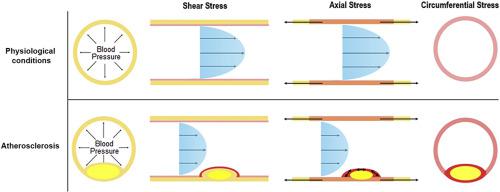当前位置:
X-MOL 学术
›
Atherosclerosis
›
论文详情
Our official English website, www.x-mol.net, welcomes your
feedback! (Note: you will need to create a separate account there.)
Exploring the relationship between biomechanical stresses and coronary atherosclerosis
Atherosclerosis ( IF 4.9 ) Pub Date : 2020-06-01 , DOI: 10.1016/j.atherosclerosis.2020.04.011 James N Cameron 1 , Ojas H Mehta 1 , Michael Michail 2 , Jasmine Chan 1 , Stephen J Nicholls 1 , Martin R Bennett 3 , Adam J Brown 1
Atherosclerosis ( IF 4.9 ) Pub Date : 2020-06-01 , DOI: 10.1016/j.atherosclerosis.2020.04.011 James N Cameron 1 , Ojas H Mehta 1 , Michael Michail 2 , Jasmine Chan 1 , Stephen J Nicholls 1 , Martin R Bennett 3 , Adam J Brown 1
Affiliation

|
The pathophysiology of coronary atherosclerosis is multifaceted. Plaque initiation and progression are governed by a complex interplay between genetic and environmental factors acting through processes such as lipid accumulation, altered haemodynamics and inflammation. There is increasing recognition that biomechanical stresses play an important role in atherogenesis, and integration of these metrics with clinical imaging has potential to significantly improve cardiovascular risk prediction. In this review, we present the calculation of coronary biomechanical stresses from first principles and computational methods, including endothelial shear stress (ESS), plaque structural stress (PSS) and axial plaque stress (APS). We discuss the current experimental and human data linking these stresses to the natural history of coronary artery disease and explore the future potential for refining treatment options and predicting future ischaemic events.
中文翻译:

探索生物力学应力与冠状动脉粥样硬化之间的关系
冠状动脉粥样硬化的病理生理学是多方面的。斑块的发生和进展受到遗传和环境因素之间复杂的相互作用的控制,这些因素通过脂质积累、血流动力学改变和炎症等过程发挥作用。人们越来越认识到生物力学应力在动脉粥样硬化形成中发挥着重要作用,将这些指标与临床影像相结合有可能显着改善心血管风险预测。在这篇综述中,我们从第一原理和计算方法出发,介绍了冠状动脉生物力学应力的计算,包括内皮剪切应力(ESS)、斑块结构应力(PSS)和轴向斑块应力(APS)。我们讨论了当前的实验和人体数据,将这些压力与冠状动脉疾病的自然史联系起来,并探讨了改进治疗方案和预测未来缺血事件的未来潜力。
更新日期:2020-06-01
中文翻译:

探索生物力学应力与冠状动脉粥样硬化之间的关系
冠状动脉粥样硬化的病理生理学是多方面的。斑块的发生和进展受到遗传和环境因素之间复杂的相互作用的控制,这些因素通过脂质积累、血流动力学改变和炎症等过程发挥作用。人们越来越认识到生物力学应力在动脉粥样硬化形成中发挥着重要作用,将这些指标与临床影像相结合有可能显着改善心血管风险预测。在这篇综述中,我们从第一原理和计算方法出发,介绍了冠状动脉生物力学应力的计算,包括内皮剪切应力(ESS)、斑块结构应力(PSS)和轴向斑块应力(APS)。我们讨论了当前的实验和人体数据,将这些压力与冠状动脉疾病的自然史联系起来,并探讨了改进治疗方案和预测未来缺血事件的未来潜力。

































 京公网安备 11010802027423号
京公网安备 11010802027423号